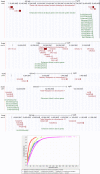PEREGRINE: A genome-wide prediction of enhancer to gene relationships supported by experimental evidence
- PMID: 33320871
- PMCID: PMC7737992
- DOI: 10.1371/journal.pone.0243791
PEREGRINE: A genome-wide prediction of enhancer to gene relationships supported by experimental evidence
Abstract
Enhancers are powerful and versatile agents of cell-type specific gene regulation, which are thought to play key roles in human disease. Enhancers are short DNA elements that function primarily as clusters of transcription factor binding sites that are spatially coordinated to regulate expression of one or more specific target genes. These regulatory connections between enhancers and target genes can therefore be characterized as enhancer-gene links that can affect development, disease, and homeostatic cellular processes. Despite their implication in disease and the establishment of cell identity during development, most enhancer-gene links remain unknown. Here we introduce a new, publicly accessible database of predicted enhancer-gene links, PEREGRINE. The PEREGRINE human enhancer-gene links interactive web interface incorporates publicly available experimental data from ChIA-PET, eQTL, and Hi-C assays across 78 cell and tissue types to link 449,627 enhancers to 17,643 protein-coding genes. These enhancer-gene links are made available through the new Enhancer module of the PANTHER database and website where the user may easily access the evidence for each enhancer-gene link, as well as query by target gene and enhancer location.
Conflict of interest statement
The authors have declared that no competing interests exist.
Figures






References
Publication types
MeSH terms
Grants and funding
LinkOut - more resources
Full Text Sources

